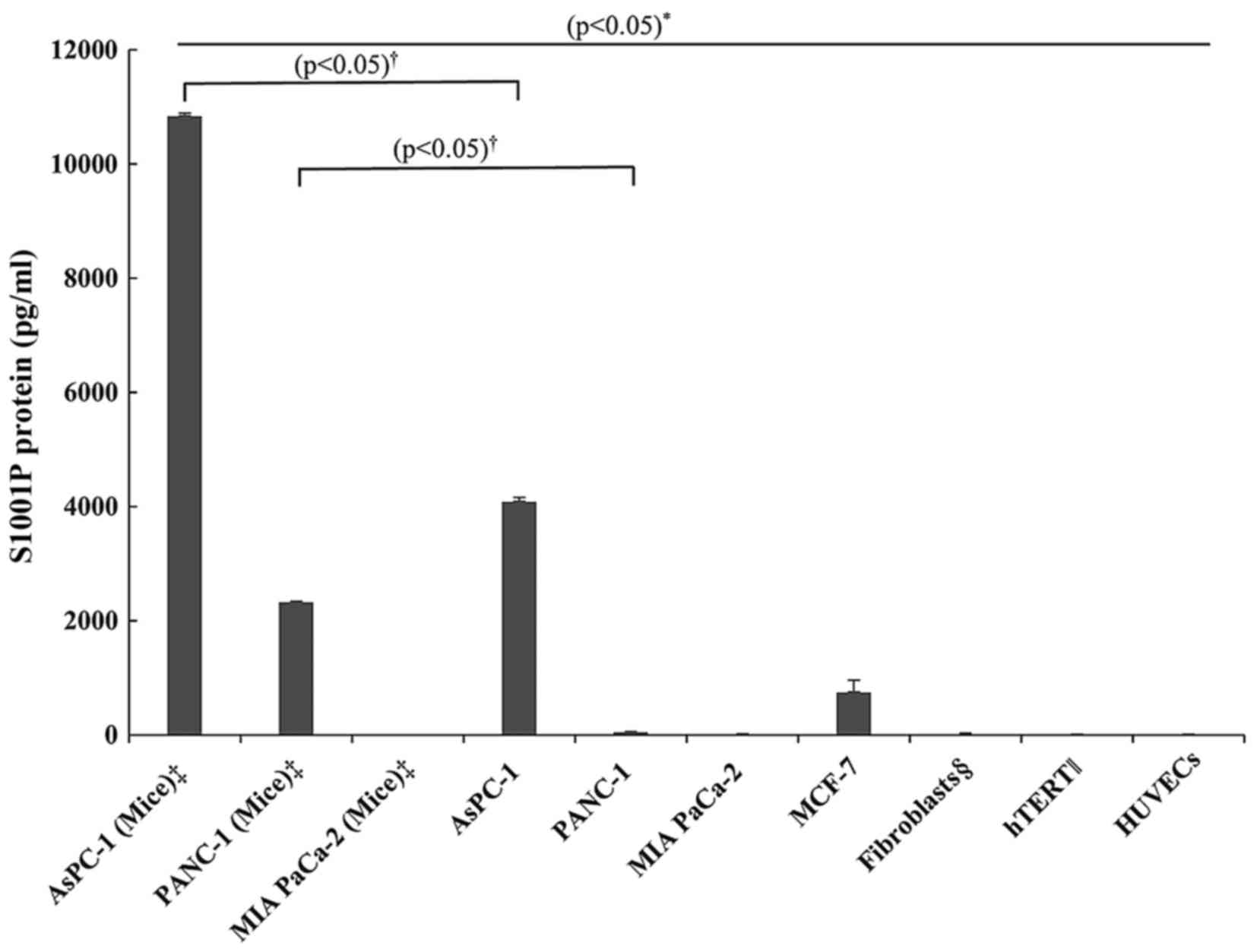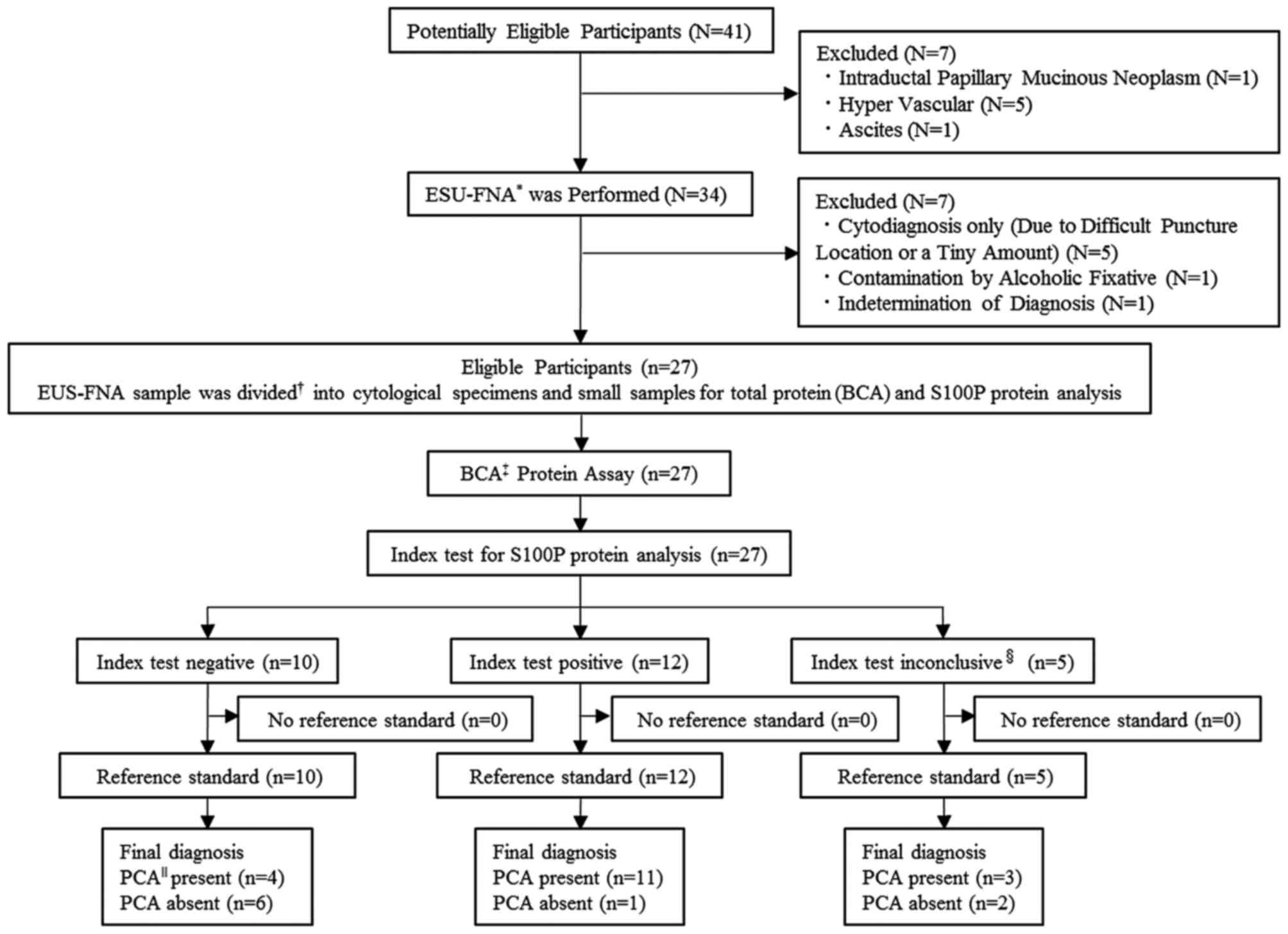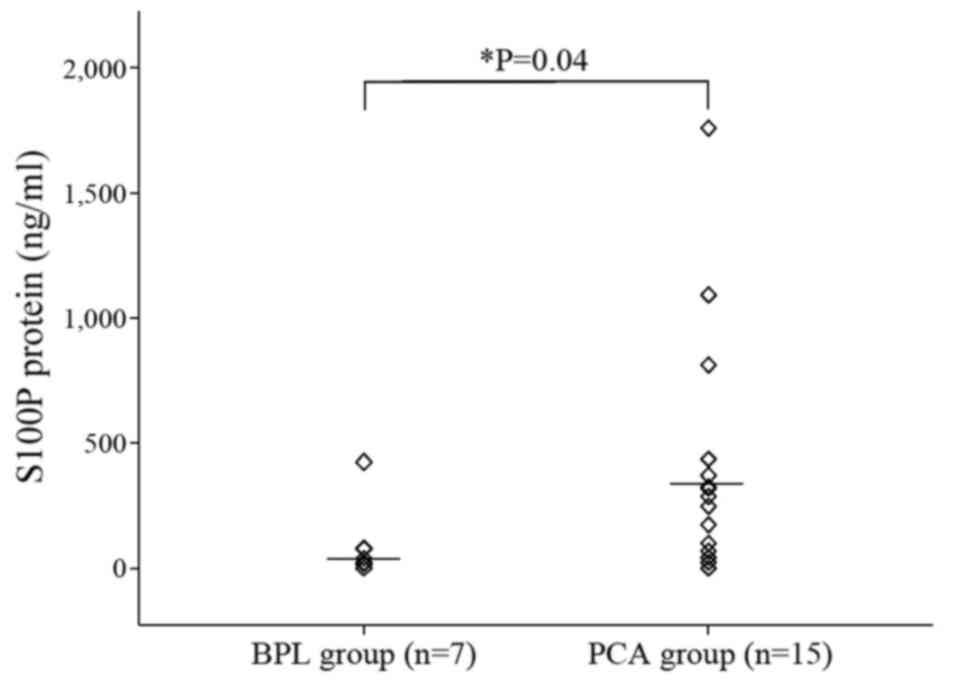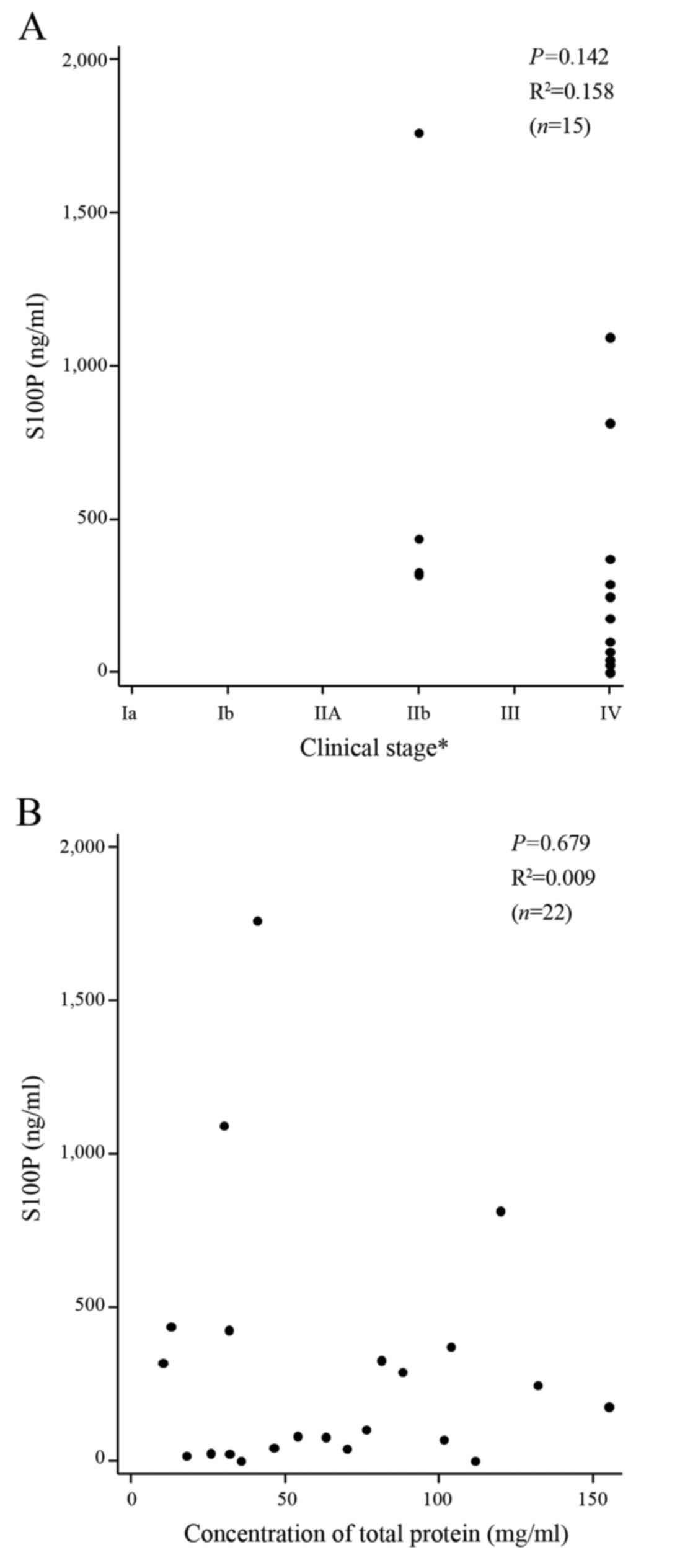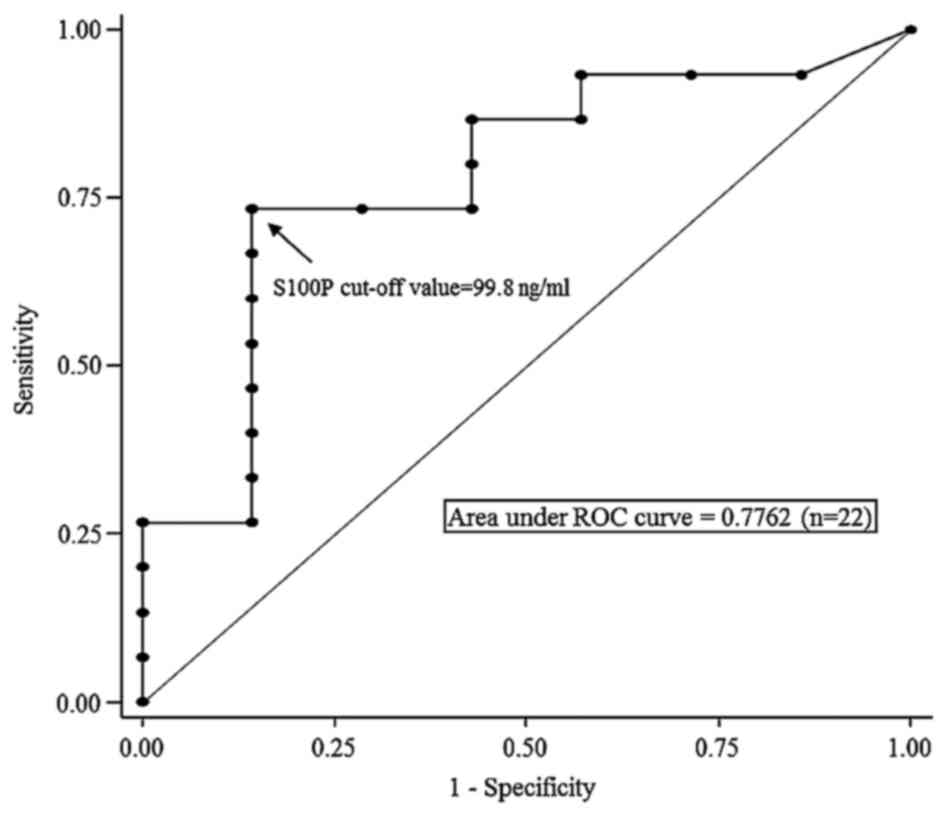|
1
|
Puli SR, Bechtold ML, Buxbaum JL and
Eloubeidi MA: How good is endoscopic ultrasound-guided fine-needle
aspiration in diagnosing the correct etiology for a solid
pancreatic mass?: A meta-analysis and systematic review. Pancreas.
42:20–26. 2013. View Article : Google Scholar : PubMed/NCBI
|
|
2
|
Savides TJ, Donohue M, Hunt G, Al-Haddad
M, Aslanian H, Ben-Menachem T, Chen VK, Coyle W, Deutsch J, DeWitt
J, et al: EUS-guided FNA diagnostic yield of malignancy in solid
pancreatic masses: A benchmark for quality performance measurement.
Gastrointest Endosc. 66:277–282. 2007. View Article : Google Scholar : PubMed/NCBI
|
|
3
|
Dina R, Tran-Dang MA, Mauri F, Gudi M,
Cohen P, Ahmad R, Batav L, Vlavianos P and Spalding D:
Pancreatobiliary cytology in the multidisciplinary setting.
Cytopathology. 24:150–158. 2013. View Article : Google Scholar : PubMed/NCBI
|
|
4
|
Bournet B, Gayral M, Torrisani J, Selves
J, Cordelier P and Buscail L: Role of endoscopic ultrasound in the
molecular diagnosis of pancreatic cancer. World J Gastroenterol.
20:10758–10768. 2014. View Article : Google Scholar : PubMed/NCBI
|
|
5
|
Fritscher-Ravens A, Brand L, Knöfel WT,
Bobrowski C, Topalidis T, Thonke F, de Werth A and Soehendra N:
Comparison of endoscopic ultrasound-guided fine needle aspiration
for focal pancreatic lesions in patients with normal parenchyma and
chronic pancreatitis. Am J Gastroenterol. 97:2768–2775. 2002.
View Article : Google Scholar : PubMed/NCBI
|
|
6
|
Varadarajulu S, Tamhane A and Eloubeidi
MA: Yield of EUS-guided FNA of pancreatic masses in the presence or
the absence of chronic pancreatitis. Gastrointest Endosc.
62:728–736; quiz 751, 753. 2005. View Article : Google Scholar : PubMed/NCBI
|
|
7
|
Krishna NB, Mehra M, Reddy AV and Agarwal
B: EUS/EUS-FNA for suspected pancreatic cancer: Influence of
chronic pancreatitis and clinical presentation with or without
obstructive jaundice on performance characteristics. Gastrointest
Endosc. 70:70–79. 2009. View Article : Google Scholar : PubMed/NCBI
|
|
8
|
Ribeiro A, Peng J, Casas C and Fan YS:
Endoscopic ultrasound guided fine needle aspiration with
fluorescence in situ hybridization analysis in 104 patients with
pancreatic mass. J Gastroenterol Hepatol. 29:1654–1658. 2014.
View Article : Google Scholar : PubMed/NCBI
|
|
9
|
Lin F and Staerkel G: Cytologic criteria
for well differentiated adenocarcinoma of the pancreas in
fine-needle aspiration biopsy specimens. Cancer. 99:44–50. 2003.
View Article : Google Scholar : PubMed/NCBI
|
|
10
|
Dim DC, Jiang F, Qiu Q, Li T, Darwin P,
Rodgers WH and Peng HQ: The usefulness of S100P, mesothelin,
fascin, prostate stem cell antigen, and 14-3-3 sigma in diagnosing
pancreatic adenocarcinoma in cytological specimens obtained by
endoscopic ultrasound guided fine-needle aspiration. Diagn
Cytopathol. 42:193–199. 2014. View
Article : Google Scholar : PubMed/NCBI
|
|
11
|
Siddiqui AA, Brown LJ, Hong SK,
Draganova-Tacheva RA, Korenblit J, Loren DE, Kowalski TE and
Solomides C: Relationship of pancreatic mass size and diagnostic
yield of endoscopic ultrasound-guided fine needle aspiration. Dig
Dis Sci. 56:3370–3375. 2011. View Article : Google Scholar : PubMed/NCBI
|
|
12
|
Iglesias-Garcia J, Dominguez-Munoz JE,
Abdulkader I, Larino-Noia J, Eugenyeva E, Lozano-Leon A and
Forteza-Vila J: Influence of on-site cytopathology evaluation on
the diagnostic accuracy of endoscopic ultrasound-guided fine needle
aspiration (EUS-FNA) of solid pancreatic masses. Am J
Gastroenterol. 106:1705–1710. 2011. View Article : Google Scholar : PubMed/NCBI
|
|
13
|
Camellini L, Carlinfante G, Azzolini F,
Iori V, Cavina M, Sereni G, Decembrino F, Gallo C, Tamagnini I,
Valli R, et al: A randomized clinical trial comparing 22G and 25G
needles in endoscopic ultrasound-guided fine-needle aspiration of
solid lesions. Endoscopy. 43:709–715. 2011. View Article : Google Scholar : PubMed/NCBI
|
|
14
|
Suzuki R, Irisawa A, Bhutani MS, Hikichi
T, Takagi T, Sato A, Sato M, Ikeda T, Watanabe K, Nakamura J, et
al: Prospective evaluation of the optimal number of 25-gauge needle
passes for endoscopic ultrasound-guided fine-needle aspiration
biopsy of solid pancreatic lesions in the absence of an onsite
cytopathologist. Dig Endosc. 24:452–456. 2012. View Article : Google Scholar : PubMed/NCBI
|
|
15
|
Yasuda I, Iwashita T and Doi S: Tips for
endoscopic ultrasound-guided fine needle aspiration of various
pancreatic lesions. J Hepatobiliary Pancreat Sci. 21:E29–E33. 2014.
View Article : Google Scholar : PubMed/NCBI
|
|
16
|
Hewitt MJ, McPhail MJ, Possamai L, Dhar A,
Vlavianos P and Monahan KJ: EUS-guided FNA for diagnosis of solid
pancreatic neoplasms: A meta-analysis. Gastrointest Endosc.
75:319–331. 2012. View Article : Google Scholar : PubMed/NCBI
|
|
17
|
Hartwig W, Schneider L, Diener MK,
Bergmann F, Büchler MW and Werner J: Preoperative tissue diagnosis
for tumours of the pancreas. Br J Surg. 96:5–20. 2009. View Article : Google Scholar : PubMed/NCBI
|
|
18
|
Logsdon CD, Simeone DM, Binkley C,
Arumugam T, Greenson JK, Giordano TJ, Misek DE, Kuick R and Hanash
S: Molecular profiling of pancreatic adenocarcinoma and chronic
pancreatitis identifies multiple genes differentially regulated in
pancreatic cancer. Cancer Res. 63:2649–2657. 2003.PubMed/NCBI
|
|
19
|
Crnogorac-Jurcevic T, Missiaglia E,
Blaveri E, Gangeswaran R, Jones M, Terris B, Costello E,
Neoptolemos JP and Lemoine NR: Molecular alterations in pancreatic
carcinoma: Expression profiling shows that dysregulated expression
of S100 genes is highly prevalent. J Pathol. 201:63–74. 2003.
View Article : Google Scholar : PubMed/NCBI
|
|
20
|
Sato N, Fukushima N, Matsubayashi H and
Goggins M: Identification of maspin and S100P as novel
hypomethylation targets in pancreatic cancer using global gene
expression profiling. Oncogene. 23:1531–1538. 2004. View Article : Google Scholar : PubMed/NCBI
|
|
21
|
Dowen SE, Crnogorac-Jurcevic T,
Gangeswaran R, Hansen M, Eloranta JJ, Bhakta V, Brentnall TA,
Lüttges J, Klöppel G and Lemoine NR: Expression of S100P and its
novel binding partner S100PBPR in early pancreatic cancer. Am J
Pathol. 166:81–92. 2005. View Article : Google Scholar : PubMed/NCBI
|
|
22
|
Ohuchida K, Mizumoto K, Egami T, Yamaguchi
H, Fujii K, Konomi H, Nagai E, Yamaguchi K, Tsuneyoshi M and Tanaka
M: S100P is an early developmental marker of pancreatic
carcinogenesis. Clin Cancer Res. 12:5411–5416. 2006. View Article : Google Scholar : PubMed/NCBI
|
|
23
|
Chen Y, Zheng B, Robbins DH, Lewin DN,
Mikhitarian K, Graham A, Rumpp L, Glenn T, Gillanders WE, Cole DJ,
et al: Accurate discrimination of pancreatic ductal adenocarcinoma
and chronic pancreatitis using multimarker expression data and
samples obtained by minimally invasive fine needle aspiration. Int
J Cancer. 120:1511–1517. 2007. View Article : Google Scholar : PubMed/NCBI
|
|
24
|
Lin F, Shi J, Liu H, Hull ME, Dupree W,
Prichard JW, Brown RE, Zhang J, Wang HL and Schuerch C: Diagnostic
utility of S100P and von Hippel-Lindau gene product (pVHL) in
pancreatic adenocarcinoma-with implication of their roles in early
tumorigenesis. Am J Surg Pathol. 32:78–91. 2008. View Article : Google Scholar : PubMed/NCBI
|
|
25
|
Kosarac O, Takei H, Zhai QJ, Schwartz MR
and Mody DR: S100P and XIAP expression in pancreatic ductal
adenocarcinoma: Potential novel biomarkers as a diagnostic adjunct
to fine needle aspiration cytology. Acta Cytol. 55:142–148. 2011.
View Article : Google Scholar : PubMed/NCBI
|
|
26
|
Bournet B, Pointreau A, Souque A, Oumouhou
N, Muscari F, Lepage B, Senesse P, Barthet M, Lesavre N, Hammel P,
et al: Gene expression signature of advanced pancreatic ductal
adenocarcinoma using low density array on endoscopic
ultrasound-guided fine needle aspiration samples. Pancreatology.
12:27–34. 2012. View Article : Google Scholar : PubMed/NCBI
|
|
27
|
Liu H, Shi J, Anandan V, Wang HL, Diehl D,
Blansfield J, Gerhard G and Lin F: Reevaluation and identification
of the best immunohistochemical panel (pVHL, Maspin, S100P, IMP-3)
for ductal adenocarcinoma of the pancreas. Arch Pathol Lab Med.
136:601–609. 2012. View Article : Google Scholar : PubMed/NCBI
|
|
28
|
Hu H, Zhang Q, Huang C, Shen Y, Chen X,
Shi X and Tang W: Diagnostic value of S100P for pancreatic cancer:
A meta-analysis. Tumour Biol. 35:9479–9485. 2014. View Article : Google Scholar : PubMed/NCBI
|
|
29
|
Deng H, Shi J, Wilkerson M, Meschter S,
Dupree W and Lin F: Usefulness of S100P in diagnosis of
adenocarcinoma of pancreas on fine-needle aspiration biopsy
specimens. Am J Clin Pathol. 129:81–88. 2008. View Article : Google Scholar : PubMed/NCBI
|
|
30
|
Augereau C, Lemaigre FP and Jacquemin P:
Extraction of high-quality RNA from pancreatic tissues for gene
expression studies. Anal Biochem. 500:60–62. 2016. View Article : Google Scholar : PubMed/NCBI
|
|
31
|
The National Cancer Institute (NCI):
Cancer Clinical Trials: The Basic Workbook [NCI Web site].
September;2002 https://accrualnet.cancer.gov/sites/accrualnet.cancer.gov/files/BasicsWorkbook_m.pdfAccessed.
October 15–2016.
|
|
32
|
Imazu H, Uchiyama Y, Kakutani H, Ikeda K,
Sumiyama K, Kaise M, Omar S, Ang TL and Tajiri H: A prospective
comparison of EUS-guided FNA using 25-gauge and 22-gauge needles.
Gastroenterol Res Pract. 2009:5463902009. View Article : Google Scholar : PubMed/NCBI
|
|
33
|
Des Jarlais DC, Lyles C and Crepaz N:
TREND Group: Improving the reporting quality of nonrandomized
evaluations of behavioral and public health interventions: The
TREND statement. Am J Public Health. 94:361–366. 2004. View Article : Google Scholar : PubMed/NCBI
|
|
34
|
Bossuyt PM, Reitsma JB, Bruns DE, Gatsonis
CA, Glasziou PP, Irwig L, Lijmer JG, Moher D, Rennie D, de Vet HC,
et al: STARD Group: STARD 2015: An Updated List of Essential Items
for Reporting Diagnostic Accuracy Studies. Clin Chem. 61:1446–1452.
2015. View Article : Google Scholar : PubMed/NCBI
|
|
35
|
Pitman MB, Centeno BA, Ali SZ, Genevay M,
Stelow E, Mino-Kenudson M, Fernandez-del Castillo C, Max Schmidt C,
Brugge W and Layfield L: Papanicolaou Society of Cytopathology:
Standardized terminology and nomenclature for pancreatobiliary
cytology: The Papanicolaou Society of Cytopathology guidelines.
Diagn Cytopathol. 42:338–350. 2014. View Article : Google Scholar : PubMed/NCBI
|
|
36
|
Pitman MB and Layfield LJ: Guidelines for
pancreaticobiliary cytology from the Papanicolaou Society of
Cytopathology: A review. Cancer Cytopathol. 122:399–411. 2014.
View Article : Google Scholar : PubMed/NCBI
|
|
37
|
Layfield LJ and Pitman MB: The
Papanicolaou Society of Cytopathology guidelines for
pancreaticobiliary tract cytology: A new installment in the
‘Bethesda’ style of guidelines from the Papanicolaou Society of
Cytopathology. Diagn Cytopathol. 42:283–284. 2014. View Article : Google Scholar : PubMed/NCBI
|
|
38
|
Lekanne Deprez RH, Fijnvandraat AC,
Ruijter JM and Moorman AF: Sensitivity and accuracy of quantitative
real-time polymerase chain reaction using SYBR green I depends on
cDNA synthesis conditions. Anal Biochem. 307:63–69. 2002.
View Article : Google Scholar : PubMed/NCBI
|
|
39
|
Parkkila S, Pan PW, Ward A, Gibadulinova
A, Oveckova I, Pastorekova S, Pastorek J, Martinez AR, Helin HO and
Isola J: The calcium-binding protein S100P in normal and malignant
human tissues. BMC Clin Pathol. 8:26890-8–2. 2008. View Article : Google Scholar : PubMed/NCBI
|
|
40
|
Arumugam T, Simeone DM, Schmidt AM and
Logsdon CD: S100P stimulates cell proliferation and survival via
receptor for activated glycation end products (RAGE). J Biol Chem.
279:5059–5065. 2004. View Article : Google Scholar : PubMed/NCBI
|
|
41
|
Arumugam T, Simeone DM, Van Golen K and
Logsdon CD: S100P promotes pancreatic cancer growth, survival, and
invasion. Clin Cancer Res. 11:5356–5364. 2005. View Article : Google Scholar : PubMed/NCBI
|
|
42
|
Arumugam T, Ramachandran V and Logsdon CD:
Effect of cromolyn on S100P interactions with RAGE and pancreatic
cancer growth and invasion in mouse models. J Natl Cancer Inst.
98:1806–1818. 2006. View Article : Google Scholar : PubMed/NCBI
|
|
43
|
Arumugam T and Logsdon CD: S100P: A novel
therapeutic target for cancer. Amino Acids. 41:893–899. 2011.
View Article : Google Scholar : PubMed/NCBI
|
|
44
|
Zhou C, Zhong Q, Rhodes LV, Townley I,
Bratton MR, Zhang Q, Martin EC, Elliott S, Collins-Burow BM, Burow
ME, et al: Proteomic analysis of acquired tamoxifen resistance in
MCF-7 cells reveals expression signatures associated with enhanced
migration. Breast Cancer Res. 14:R452012. View Article : Google Scholar : PubMed/NCBI
|
|
45
|
Wu Z, Boonmars T, Nagano I, Boonjaraspinyo
S, Srinontong P, Ratasuwan P, Narong K, Nielsen PS and Maekawa Y:
Significance of S100P as a biomarker in diagnosis, prognosis and
therapy of opisthorchiasis-associated cholangiocarcinoma. Int J
Cancer. 138:396–408. 2016. View Article : Google Scholar : PubMed/NCBI
|
|
46
|
Missiaglia E, Blaveri E, Terris B, Wang
YH, Costello E, Neoptolemos JP, Crnogorac-Jurcevic T and Lemoine
NR: Analysis of gene expression in cancer cell lines identifies
candidate markers for pancreatic tumorigenesis and metastasis. Int
J Cancer. 112:100–112. 2004. View Article : Google Scholar : PubMed/NCBI
|
|
47
|
Fukushima N, Sato N, Prasad N, Leach SD,
Hruban RH and Goggins M: Characterization of gene expression in
mucinous cystic neoplasms of the pancreas using oligonucleotide
microarrays. Oncogene. 23:9042–9051. 2004. View Article : Google Scholar : PubMed/NCBI
|
|
48
|
Shimosegawa T, Chari ST, Frulloni L,
Kamisawa T, Kawa S, Mino-Kenudson M, Kim MH, Klöppel G, Lerch MM,
Löhr M, et al: International Association of Pancreatology:
International consensus diagnostic criteria for autoimmune
pancreatitis: Guidelines of the International Association of
Pancreatology. Pancreas. 40:352–358. 2011. View Article : Google Scholar : PubMed/NCBI
|















